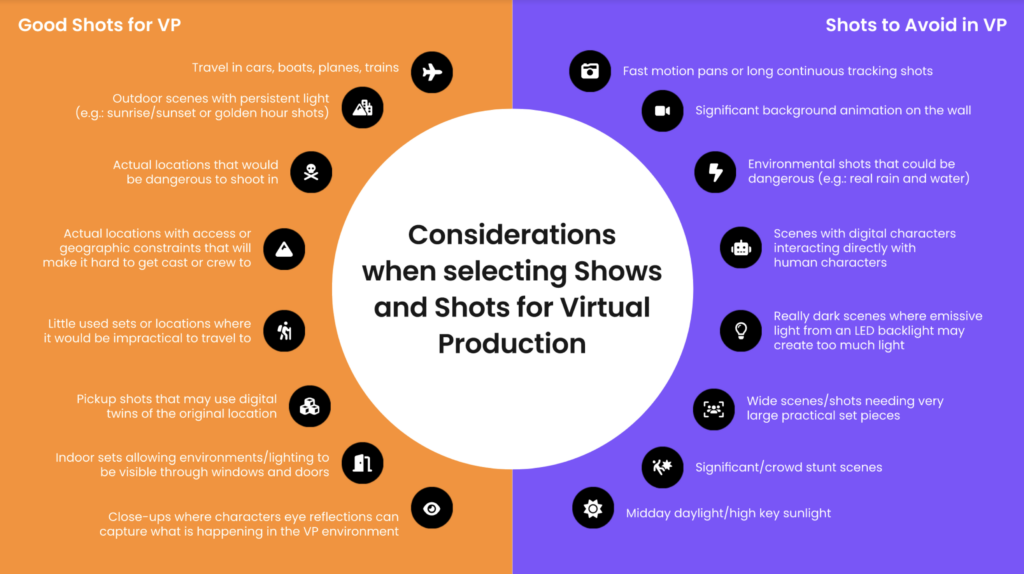M+E Europe

New Virtual Production Paper Aims to De-Mystify the Process
Story Highlights
A new white paper from Entertainment Technologists and NEP Virtual Studios — “Demystifying Virtual Production” — examines key questions about how to budget, plan and execute virtual production in modern TV and movie workflows.
Aimed at producers and studio executives, the free paper is paired with a budget and scheduling calculator for producers to help decide where and how to apply emerging virtual production technologies when planning their next production.
Mark Turner, president of Entertainment Technologists, spoke with MESA about how the paper addresses the most common questions producers may have, how the results of the paper produced some surprises, and how the industry can embrace virtual production by having an open dialogue around the risks and benefits.
MESA: Was there anything that surprised you about the state of virtual production as a result of the white paper?
 Turner: Yes. The rapid development of the technology is outpacing the innovation in workflows and industry understanding that is required to actually make use of the technology. There are producers and creatives who have heard of VP and maybe like to try it, but too few of them are experienced and have used it to be able to advocate for its ability to accelerate decision making and its impact on budget.
Turner: Yes. The rapid development of the technology is outpacing the innovation in workflows and industry understanding that is required to actually make use of the technology. There are producers and creatives who have heard of VP and maybe like to try it, but too few of them are experienced and have used it to be able to advocate for its ability to accelerate decision making and its impact on budget.
We’re an industry which is very slow to adopt change (because it’s natural to be risk adverse when trusted with a $100 million budget on a project that simply can’t be late or overspend) so for VP to be successful we need to share our triumphs and be honest about our failures and let the whole creative community participate in that process and get some hands on experience with the power of the tools.
MESA: What’s being done well in the world of virtual production, and what can be improved upon?
Turner: Obviously in-camera VFX (ICVFX) using sometimes giant LED walls is powering much of the innovation right now and it’s amazing, but the real-time rendering that powers those walls can really help in other areas of the production pipeline — from pitchViz and virtual scouting through previz, review/approvals and even VFX Pulls.
In the paper we really explore this idea that virtual production is not really about the technologies themselves but the changes in workflow that those technologies enable — and that is the part that the industry needs to discuss more. VP, if done right, can enable rapid decision making throughout the creative process by blending the physical and digital worlds but that does require not just a different approach to production but also a different mindset to when assets are created, stored, accessed, and shared.
Productions looking to just swap out green screen shots with an LED wall will only realise a fraction of the benefits of Virtual Production as it’s only with this holistic approach that all of the benefits in speed, costs and iteration can be realised.
MESA: On the budget side, what are the biggest advantages for virtual productions, and what are the biggest pitfalls that need to be avoided?
 Turner: Well, it’s far from guaranteed that an overall budget will be lowered using virtual production, but there are certainly productions that have done that. But every budget and schedule are impacted by the movement of spend and tasks — for example moving asset building out of post and way upstream into pre-production.
Turner: Well, it’s far from guaranteed that an overall budget will be lowered using virtual production, but there are certainly productions that have done that. But every budget and schedule are impacted by the movement of spend and tasks — for example moving asset building out of post and way upstream into pre-production.
The biggest pitfall is running into a VP shoot without having it well planned, with all assets built, tested (on the actual infrastructure used) and with an underlying team that can prepare and adapt to changes on set. The worst-case scenario is having to redo shots in post VFX that were supposed to be ‘final’ when shot on a virtual production stage. This motion graphic offers a look at how the pre-production process needs to be extended with virtual production.
MESA: What (or who) informed the best practices section of this white paper?
Turner: I was lucky enough to work with the NEP Virtual Studios experts on the paper who have worked on literally hundreds of productions over the years and interview producers, cinematographers and directors who have used the technologies and experimented in workflows. So, the recommendations in the paper have been informed by real productions and from those that have the bruises!
MESA: The paper concludes by acknowledging that already changes have occurred in virtual production, since the paper’s release. How is the industry going to manage to keep up, in your opinion?
Turner: Dialog. And more stages being willing to open to the guilds to allow creative teams to come in, experiment and build their confidence in the technologies and its capabilities. Things are moving fast nowadays so at this stage we really need more education, conversation and sharing.









